Columbia
ISA
Audio
– Video
World
Power for Audio/Video Devices
Google SEARCH COLUMBIA ISA AUDIO VIDEO

• Surround
Sound over HDMI
• How
to hookup surround sound
• Blu-ray
audio surround sound
Columbia ISA
home – › Wiring
Diagrams –
› Electric Power in various countries around the world
Google Search
Google
SEARCH Columbia ISA Site
Columbia
ISA home
• Internet-capable
HDTVs and also Internet-capable
Blu-ray Players with Wi-Fi.
Electric
power
: When you Travel
Power
and electric standards around the world
Plugs,
adapters for travel to different countries
How to adapt audio/video devices to work in another country
• Universal Travel Adapter 100-220V to 110V Voltage Converter
Universal Travel Adapter 100-220V to 110V Voltage Converter 250W with 6A 4-Port USB Charging 3 AC Sockets and EU/UK/AU/US/India Worldwide Plug Adapter (White)
What do I
need to operate my audio or video device in a country other
than my own?
If your equipment is compatible with the local line voltage and frequency, all you need is a plug adapter so that you can connect the plug to a foreign socket. However, this is often not the case.
TV channels and broadcast signals differ from country to country and you can generally use a TV set only in the country for which it was designed.
The two things you need to know about the AC power in any country are the voltage (measured in volts) and the frequency (measured in Hertz, Hz, or cycles per second).
The United States uses 110-120 volts, 60 Hz, as do Canada and Mexico.
USA also uses 220-240 volts for appliances such as ovens, dryers, air
conditioners and these have a different outlet than 110-120V outlets.
Most of Europe and Asia use 220-240 volts, 50 Hz. Japan uses 100 volts, 50 or 60 Hz depending on region.
If your newer device's power supply accepts everything from 100 to 240 volts, 50 to 60 Hz, then you are in luck.
The newer devices have integrated-circuit voltage regulators. You can use them anywhere with only a plug adapter.
Look for the following
on the label of an AC Adapter for example: INPUT : 100-240V 50-60Hz For Indoor Use Only - Connect to a grounded outlet.
Some devices have a switch for 110-120V or 220-240V.

The chances are you need to consider all of the following:
1)
Voltage
2)
Watts
3)
Physical
plugs
4)
Media Formats
Voltage needs to be considered because voltage varies depending on
where you are in the world. Electrical devices must have the proper
voltage to operate within their design. It is often too easy to take
for granted that you have the proper voltage at the wall plug. When in
another country this could change because voltage at the wall plug is
sometimes different or inconsistent when you move to a far off location
in another part of the world.
Watts need to be considered along with voltage to be sure your
electrical device has the proper electrical power limits, both lower
and upper.
Physical plugs are different depending on which country or region you
are in. Adapter plugs are available to allow physically incompatible
electrical connections to make an electrical circuit.
Media formats also need to be considered as once again different parts
of the world use their own standards for TV broadcasts, DVD and other
media forms.
VOLTS
With a few exceptions, most countries around the world use 220 to 240
volts at the consumer individual outlet. Therefore devices made for
these countries are designed to operate at 220 to 240 volts. On the
other hand, Canada, Mexico, USA, Japan, some central American and South
American countries and some others use a lower 100 to 120 volts for
most appliances and consumer devices. Devices made for these countries
operate at 100 to 120 volts. The operating voltages are different
depending on which country you are in.
When in the USA and you plug your device into a wall outlet you get
electric power at 110 to 120 Volts at 60Hz. Your made for America
component typically operates at 110-120V and as long as you operate the
device in the USA everything works fine. But if you travel to the U.K.
for example, you may be incompatible because in the U.K. power is
delivered at 220 to 240 volts at 50Hz from the wall socket.
In
addition, the physical plug is incompatible. Your USA style standard
power plug will not fit into the outlet in the U.K. To solve the
voltage issue you may need a step-down transformer which will take the
220 volts and step it down to 110 volts so your device will work. To
solve the physical plug problem, you may need an adpater plug to allow
you to physically plug in.
In the United States household electricity is supplied by your local
power company or municipal utility at 110 to 120 volts at a frequency
of 60 Hz. 220 to 240 volts is also available for ovens, clothes dryers
and other appliances which need higher current but these devices have a
different plug than standard 110V devices. The quantity available in
American homes is generally 15 to 20 amps at a single outlet or for the
total of all outlets served by a single fused circuit. Thus, one
circuit may provide from 1650 to 2400 watts of power. One circuit
usually supplies more than one outlet, and many people use a doubler
plug or power strip so they can use more lights or appliances from a
single outlet. This can cause blown fuses. Instead of fuses, circuit
breakers (CBs) are used in most homes built in the last few decades.
In Europe, electricity is generally supplied at 220 to 240 volts and a
frequency of 50 Hz. Officially it is 230 volts plus or minus 10%. Some
localities have 110 volts, but 50 cycles is the standard frequency
regardless of the voltage throughout France, Italy, Germany, England,
Spain, and the rest of Europe. The quantity available depends on the
location.
Watts
You have to be aware of the wattage your device uses when it operates.
A step-down transformer has a rating of a certain maximum watts. You do
not want to exceed this number of watts. If your step-down transformer
has a rating of 100 watts, then you do not want to use it with a hair
dryer because a hair dryer usually uses 1000 watts or more. If your
device does not state how many watts it uses (most do) but does state
the voltage and amps, you can calculate watts by multiplying volts
times amps. To calculate amps if you have volts and watts, divide watts
by volts. For example if a device is rated 24 watts and uses 120 volts,
then it uses 0.2 amps. Because some devices use double or even triple
the watts when first powered up (surge), you should get a transformer
with enough watt rating to account for the extra power surge.
Physical
Plugs
The plug at the end of your power cord may be physically incompatible
with the wall outlet in another country. To solve this problem you need
an adapter plug. These are available for different countries or you can
buy a universal adapter which will work in many different countries. Be
aware however that just adapting the physical plug does not necessarily
solve the voltage difference issue.
Transformers
- convert Voltage
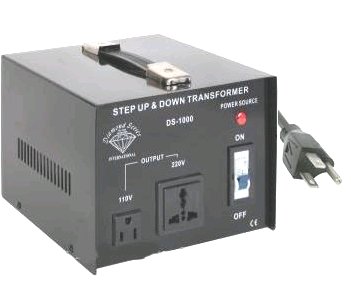
A 220 volt to 110 volt transformer is made of solid steel plates and
two coils of copper wire. Electricity is introduced into the primary
coil and comes out at the secondary coil. The change in voltage equals
the ratio of the number of turns in each coil. Thus, a 220/110 volt
transformer has half as many turns in the secondary coil as in the
primary coil.
A transformer can be used to change European electricity so that it can
be used in American specification devices. Transformers come in all
sizes. The common travelers transformer is 50 watts and can be used for
small electrical devices. Larger transformers can be used for bigger
devices. Look at the electrical nameplate on your equipment to find out
how much power it requires. Get a transformer with about twice the
capacity. A transformer should cost less than $100 for 500 watts.
How to connect the
transformer:
The step-down transformer typically has a socket to plug in your
American device. This socket should output 110 to 120 volts. The
transformer should have a power cord with a plug which would insert
either directly into the wall outlet or into an adapter plug for your
country of interest, and the adapter plug goes into the wall outlet.

CAUTION: Transformers can get hot. Be aware of potential heat problems
and be prepared to get a different transformer or another solution if
unusual heat buildup becomes an issue.
If you need a hair dryer, iron, or similar item, buy a 220v/110v dual
voltage unit.
Multi-voltage
devices
Many appliances are "multi-voltage" or "dual-voltage". If you have an
electrical device that you want to use in another country (where the
voltage can be 220/230/240) and the device is multi-voltage ( input
100-240 volts ) or dual voltage ( input 125/250 volts ) you usually
only need a plug adapter. The input voltage (and the watts or amps)
information can usually be found on a charger but it could be anywhere
on the device. It is often on the main body in the same color where it
can be difficult to see. Some dual voltage devices have switches and
some others are self-sensing, switching to the higher voltages for you
automatically.
Many devices such as laptops or digital cameras have a black brick
adapter to run the device and charge the battery. The black bricks
always have their electrical specifications embossed or printed on the
back side. If your brick says "Input: 100-240V~50/60Hz" this tells you
that it works on both American (110 volt 60 HZ) and European (220 volt
50 Hz) electricity. Most new laptops sold today operate on 110V or 220V
and 50Hz or 60Hz. Their power adapter converts the alternating current
into direct current where the power frequency is not a factor.
If you determine that your devices only need plug adapters, make sure
you get ALL the plug adapters you need. Many countries have more than
one configuration so there are often more than one adapter required.
Most, not all, laptops, cell phone chargers, digital camera chargers,
camcorder chargers, and similar chargers are multi-voltage. If they
are, they will say somewhere (on the charger usually), input 100-240
volts, 50/60 Hz.
Dual voltage appliances are extremely convenient when traveling. They
allow you to avoid the weight, hassle and having to deal with heavy
transformers and voltage converters. They save money also because most
are ungrounded and ungrounded plug adapters are less expensive and more
compact than grounded adapters.
If a device is not multi or dual voltage but you still want to use it
when you travel, you will need a transformer or a combination
transformer. Any device containing any electronic components such as
laptops, chargers, some hair straighteners, etc. will require an actual
transformer.
If your device is not multi or dual voltage, but you still want to use
it when you travel, there are voltage converters that can perform both
functions with some restrictions. These voltage converters can handle
both electronic appliances up to 50 watts and non-electronic appliances
up to 2000 watts. Most small electronic devices are under 50 watts.
Most hair dryers are under 2000 watts. Transformers usually have no
limitations other than to be sure you don't exceed its watt rating.
If you want to use a surge protector for your electronic appliances
while overseas, you definitely want to consider surge protectors which
are rated up to 250 volts. A USA surge protector cannot be used in
220-240 volt countries since they are designed and approved for a
maximum voltage of 125 volts.
If your device requires a transformer, transformers are available in
sizes from 50 watts and 100 watts up to 8000 watts and in a variety of
types which may or may not apply to you. Transformers are sized
according to the maximum watts (amps) that they can provide.
All appliances have the watts (or sometimes amps) they require posted
somewhere on them. The appliance may list the power required as so many
amps (for example, .5 A) in which case you can multiply volts times
amps to find the watts (V x A = W). In the example .5 A times 120 volts
equals 60 watts. It may also show the amps as so many mA (milli-amps).
In this example, 50 mA converts (50 divided by 1000 = .05) to .05 amps.
In the same formula, .05 times 120 (volts) = 6 watts as an example.
Worldwide electrical outlets and plugs
There are 15 different kinds of electrical outlets and electrical plugs around the world.
Each is assigned a letter, starting with A and ending with O. Many countries use more than one plug type.
For example, in Vietnam, power plugs and sockets (outlets) of type A, type C and type D are used.
Their standard voltage is 110 / 220 V at a frequency of 50 Hz.
Another example, in Lebanon, power plugs and sockets (outlets) of type A, type B, type C, type D and type G are used.
Their standard voltage is 220 V at a frequency of 50 Hz.
Type A plugs & outlets
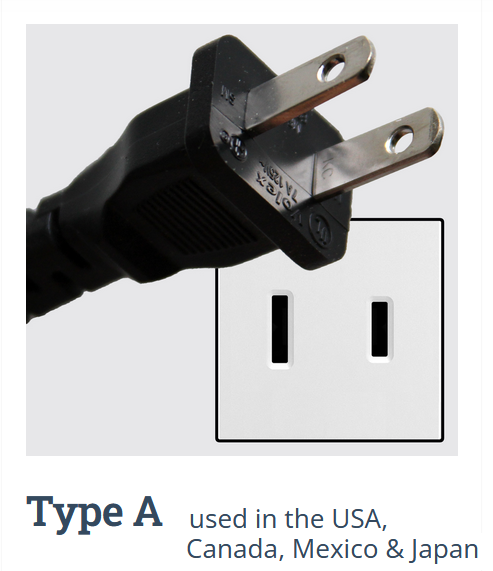
The type A plug has 2 parallel prongs and is used in
North America (USA, Canada, Mexico plus others) and Central America, and Japan.
The complete list of countries which use Type A plugs and
also some may use different type plugs as well, are:
American Samoa, Anguilla, Antigua, Aruba, Bahamas, Bangladesh, Barbados, Bermuda, Bolivia, Brazil, Cambodia, Canada, Cayman Islands, China (without holes in blades and slightly shorter blades), Colombia, Costa Rica, Cuba, Ecuador, El Salvador, Guam, Guatemala, Guyana, Haiti, Honduras, Jamaica, Japan, Laos, Lebanon, Liberia, Maldives, Mexico, Micronesia, Montserrat, Netherlands Antilles, Nicaragua, Niger, Okinawa, Panama, Peru, Philippines, Puerto Rico, St. Vincent, Saudi Arabia, Tahiti, Taiwan, Thailand, United States, Venezuela, Vietnam, Virgin Islands (U.S.& British), Yemen.
Technically known as the NEMA 1-15 (North American 15 A/125 V ungrounded), this simple plug has two flat parallel pins, or blades.
Early designs allowed the blades to be inserted either way, but more modern plugs make the neutral blade wider than the live blade so that a polarized plug can only be inserted one way. New polarized Type A plugs will not fit in old Type A sockets, but both old and new Type A plugs will fit into new Type A and Type B sockets. A similar plug and socket are commonly found in Japan, the JIS C 8303, Class II (Japanese 15 A /100 V ungrounded). It is basically identical to the North American, but incorporates stricter dimensional requirements for the plug housing, marking, and mandatory testing and approval. Japanese plugs should be able to fit North American outlets, but North American polarized plugs may require adapters or replacement non-polarized plugs in order to connect to older Japanese outlets.
2 pins (blades)
not grounded
15 A
almost always 100 – 127 V
outlet compatible with type A plugs
Type B plugs & outlets

See Type A for countries (USA, Canada etc.) except for Bangladesh, Bolivia, Cambodia, China, Dominican Republic, Korea, Liberia, Maldives, Peru, St. Vincent, Tahiti, Thailand, Vietnam, Yemen. Also found in Azores, Belize, Trinidad and Tobago.
The technical name for the Type B is NEMA 5-15 (North American 15 A/125 V ground ed). It is also called the North American 3-pin. The ground pin is longer than the live and neutral blades, so the device is grounded before the power is connected. The Type B outlet has a ground at the bottom, the neutral slot to the left, and the live slot to the right. This outlet can also be installed with the ground at the top or to either side. Japan also uses a Type B similar to the North American, but it is less common than the Type A equivalent.
This plug has a U-shaped or round ground pin. The official name of this plug is NEMA 5-15 in the USA.
3 pins
grounded
15 A
almost always 100 – 127 V
outlet compatible with type A and type B plugs
Type C plugs & outlets
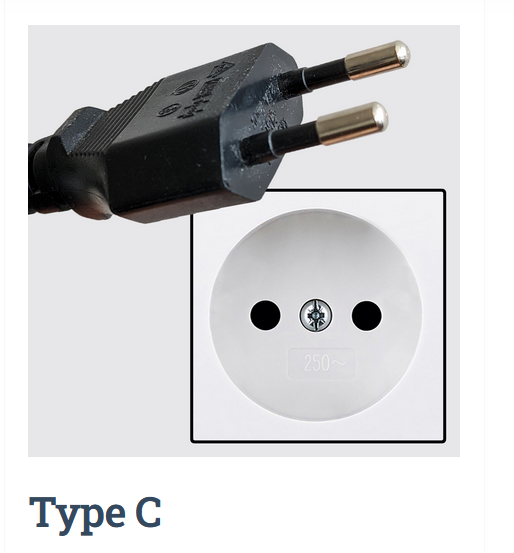
Popularly known as the Europlug, the Type C electrical plug is a two-pin unearthed plug used throughout continental Europe, parts of the Middle East, and much of Africa, South America, central Asia, and the former Soviet republics.
Type C outlets and plugs are used in every European country, except the United Kingdom, Ireland, Cyprus and Malta.
This plug is called the Europlug and its official name is CEE 7/16.
Widely used in Europe and some regions of South America and Asia.
Albania, Algeria, Angola, Argentina, Austria, Azores, Balearic Islands, Bangladesh, Belgium, Bolivia, Bosnia, Brazil, Bulgaria, Burkina Faso, Burundi, Cameroon, Canary Islands, Cape Verde, Central African Republic, Channel Islands, Chile, Comoros, Congo, Croatia, Dem. Rep. of Congo (Zaire), Cote d'Ivoire (Ivory Coast), Cyrpus, Denmark, Djibouti, Egypt, El Salvador, Equatorial Guinea, Eritrea, Faeroe Islands, Finland, French Guiana, Gabon, Germany, Gibraltar, Greece, Greenland, Guadeloupe, Guinea, Guinea-Bissau, Hungary, Iceland, India, Indonesia, Iran, Iraq, Isle of Man, Israel, Italy, Kazakhstan, Korea, Kuwait, Laos, Lebanon, Lithuania, Luxembourg, Macedonia, Madagascar, Madeira, Mali, Martinique, Mauritania, Mauritius, Monaco, Montenegro, Morocco, Mozambique, Myanmar, Nepal, Netherlands, Niger, Norway, Oman, Pakistan, Paraguay, Peru, Philippines, Poland, Portugal, Romania, Russia, Rwanda, St. Vincent, Senegal, Serbia, Slovenia, Somalia, Spain, Sudan, Suriname, Sweden, Switzerland, Syria, Thailand, Togo, Tunisia, Turkey, Uruguay, Vietnam, Zambia.
2 pins
not grounded
2.5 A, 10 A and 16 A
almost always 220 – 240 V
outlet compatible with type C plug
The Type C plug is technically known as the CEE 7/16 (Europlug 2.5 A/250 V unearthed). There is a similar plug with slightly larger pins known as the CEE 7/17. Both types are unearthed and have two round pins which converge slightly. The CEE 7/16 is intended for devices that require 2.5 A or less. The 19 mm separation of the pins and the pins' 4 mm length allow for its safe insertion in most Type C, Type E, Type F, Type H, and some Type L outlets. The larger CEE 7/17 has a round plastic or rubber base that prevents it from being inserted into small sockets. The base has holes to accommodate the side contacts and socket earth pins.
Type D plugs & outlets
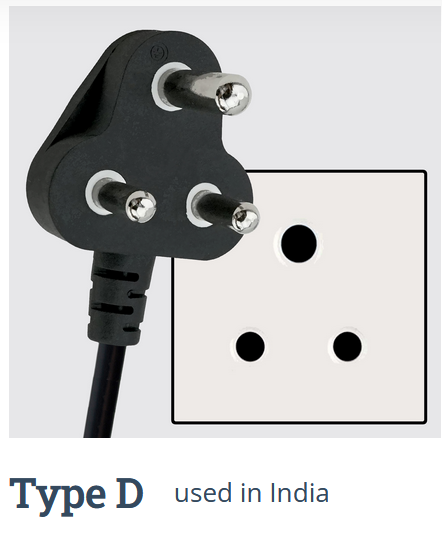
The Type D electrical plug is also known as the Old British Plug. It has three large round pins in a triangular configuration, and may be found in countries that were originally electrified by the British.
Type D plugs and outlets are almost exclusively used in India and Nepal.
The technical name for the Type D plug and receptacle is the BS 546 (5 A/250 V earthed). This type was the standard in the UK until the 1940s. It was also previously used in South Africa, but has been phased out by the Type M. In other former British colonies, the plug has been mostly replaced by the Type G. Today, the Type D 5 A, and its 2 A cousin, are sometimes used in the UK for centrally switched lighting circuits, in order to distinguish them from normal power circuits.
3 pins
grounded
5 A
220 – 240 V
outlet compatible with type D plug
Type E plugs & outlets
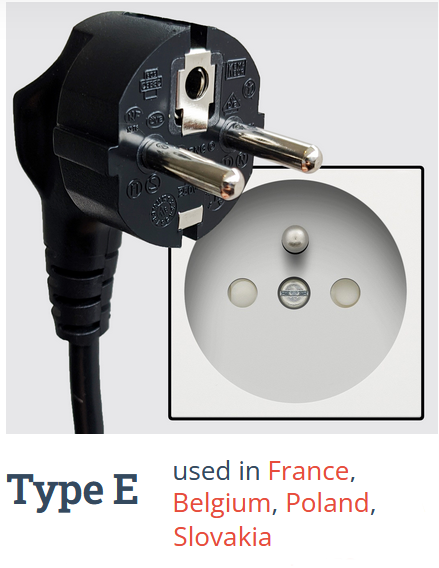
The Type E socket is standard in France, Belgium, Denmark, Poland, and other countries . It is incompatible with the Type F that is standard in Germany, the Netherlands, and other continental European countries. The incompatibility is due to the round male pin in the socket that earths appliances. The Type E socket's male pin is installed upwards in the socket, with the live connection the left and neutral connection the right.
Type E outlets are very similar to type C, but with an earth pin.
Mainly used in Belgium, France, Poland, Slovakia, Czech Republic, Tunisia and Morocco.
Belgium, Burkina Faso, Burundi, Cameroon, Canary Islands, Central African Republic, Chad, Comoros, Congo, Cote d'Ivoire (Ivory Coast), Czech Republic, Djibouti, El Salvador, Equatorial Guinea, France, French Guiana, Greece, Guadeloupe, Ireland, Indonesia, Italy, Laos, Latvia, Lithuania, Madagascar, Mali, Martinique, Monaco, Morocco, Niger, Poland, St. Vincent, Senegal, Slovakia, Syria, Tahiti, Tunisia.
2 pins
grounded
16 A
220 – 240 V
outlet compatible with type C, E and F plugs
Type F plugs & outlets
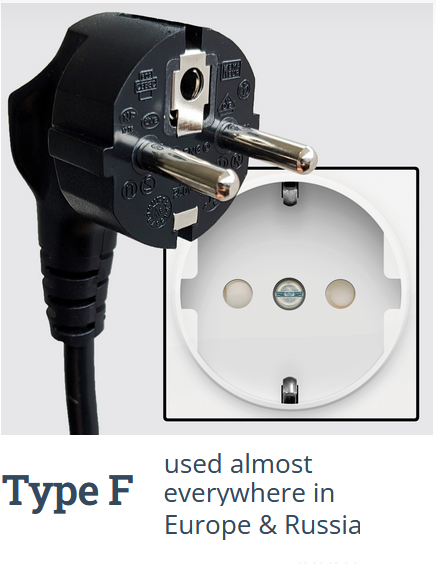
Type F outlets and plugs are used in the Netherlands, Germany, Austria, Sweden, Norway, Finland, Portugal, Spain, Turkey and Eastern Europe. Type F plug is also called CEE 7/4 or Schuko plug.
Schuko is the acronym of Schutzkontakt, which in German means protection contact or safety contact.
This plug was originally designed in Germany. It is not perfectly round as it has two plastic notches on the left and right side.
A CEE 7/7 plug can be plugged into type E and type F outlet.
Used in Russia and nearly everywhere in Europe, except United Kingdom and Ireland.
2 pins
grounded
16 A
220 – 240 V
outlet compatible with type C, E and F plugs
Type G plugs & outlets

British outlets have three rectangular holes and are known as BS 1363.
Each outlet must be grounded and they almost always have a switch for additionnal safety.
Type G outlets also have a child protection device to prevent accidents.
The earth pin is slightly longer than the other two pins and when a plug is plugged into an outlet, the earth pin pushes back a shutter that opens the two other holes and allows for the insertion of the plug.
As type C plugs do not have such an earth pin, it is almost impossible to insert a Europlug in a type G outlet, unless you stick a pointy object in the earth hole.
The Type G plug is commonly known as the 13-amp plug, and technically known as the BS 1363 (British 13 A/230-240 V 50 Hz earthed and fused). For safety reasons, UK wiring regulations require home sockets to have shutters over the live and neutral connections. These shutters are opened by the insertion of the longer earth pin. The shutters also help prevent the use of incompatible plugs made to other standards.
Mainly used in United Kingdom (England, Wales, Scotland), Ireland, Malta, Malaysia, Singapore and the Arabian peninsula.
Bahrain, Bangladesh, Belize, Botswana, Brunei, Cameroon, Channel Islands, China, Cyprus, Dominica, El Salvador, Gambia, Ghana, Gibraltar, Grenada, Guatemala, Guyana, Hong Kong, Iraq, Ireland, Isle of Man, Jordan, Kenya, Kuwait, Lebanon, Macau, Malawi, Malaysia, Maldives, Malta, Mauritius, Myanmar, Nigeria, Oman, Qatar, St. Kitts-Nevis, St. Lucia, St. Vincent, Saudi Arabia, Seychelles, Sierra Leone, Singapore, Tanzania, Uganda, United Arab Emirates, United Kingdom (England, Wales, Scotland), Vietnam, Yemen, Zambia, Zimbabwe.
3 pins
grounded
13 A
220 – 240 V
outlet compatible with type G plugs
Type H plugs & outlets
Type H plugs have an earth pin and two other V-shaped pins.
Used in Israel and Palestine.
3 pins
grounded
16 A
220 – 240 V
outlet compatible with type C and H plugs
Type I plugs & outlets
This grounded plug has two V-shaped thick flack pins.
Mainly used in Australia, New Zealand, China and Argentina.
2 or 3 pins
2 pins: ungrounded / 3 pins: grounded
10 A
220 – 240 V
outlet compatible with type I plugs
Type J plugs & outlets
Switzerland has its own standard (SEV 1011), similar to type C, except that Swiss plugs also have an earth pin in the middle.
Almost exclusively used in Switzerland and Liechtenstein.
3 pins
grounded
10 A
220 – 240 V
outlet compatible with type C and J plugs
Type K plugs & outlets
Denmark has its own standard (DS 60884-2-D1). Unlike type E system, the earth pin is not mounted in the outlet, but is on the plug.
Almost exclusively used in Denmark and Greenland.
3 pins
grounded
16 A
220 – 240 V
outlet compatible with type C and K plugs
Type L plugs & outlets
Type L system is almost exclusively used in Italy, Chile and Uruguay, sometimes also in North Africa.
3 pins
grounded
10 A and 16 A
220 – 240 V
10 A outlet compatible with types C and L plugs (10 A version)
16 A outlet compatible with type L plugs (16 A version)
Type M plugs & outlets
Type M is almost exclusively used in South Africa, Swaziland and Lesotho.
Type M plug is similar to type D, with its three prongs forming a triangle, but they are not compatible.
Mainly used in South Africa.
3 pins
grounded
15 A
220 – 240 V
outlet compatible with type M plugs
Type N plugs & outlets
Type N consists of two pins and one earth pin that form a triangle.
Type N is the most compact, robust and safest system in the world.
Used in Brazil and South Africa.
3 pins
grounded
10 A, 16 A and 20 A
100 – 240 V
outlet compatible with types C and N plugs
Type O plugs & outlets
Type O is used only in Thailand.
3 pins
grounded
16 A
220 – 240 V
outlet compatible with types C and O plugs
JAPAN
The outlets in Japan are very similar to the outlets in U.S. however,
they do not have as many grounded (3 pin) and polarized (one flat pin
bigger than the other) outlets. The voltage in Japan is 100 volts and
the frequency is 50 Hz in some areas and 60 Hz in others. There is no
practical way to change frequency but many U.S. appliances will only be
marginally affected by this difference. Clocks are a noted exception.
50 Hz power used on a clock designed for 60Hz power means it will run
5/6 speed meaning it will always be slow. Better to use a small battery
powered LCD alarm clock or use a wristwatch.
MEXICO
Mexico has a voltage of 127 volts in most areas but varies widely
(higher or lower). It is best to contact somewhere you are going to
find out if you are going to have problems with your appliances. There
is no practical solution to this voltage situation.
The voltage and frequency in Colombia, El Salvador, Haiti, Costa Rica,
parts of Ecuador, and some other countries are the same as in the USA.
The outlets, however, while very similar to the outlets in the U.S. do
not have as many grounded (3 pin) and polarized (one flat pin bigger
than the other) outlets. It is best to contact your destination to find
out if you are going to have problems with your devices.
• Voltage
super store.com Transformers, Plug adapters
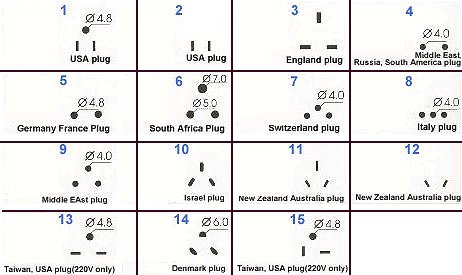
Worldwide plug and outlet configurations
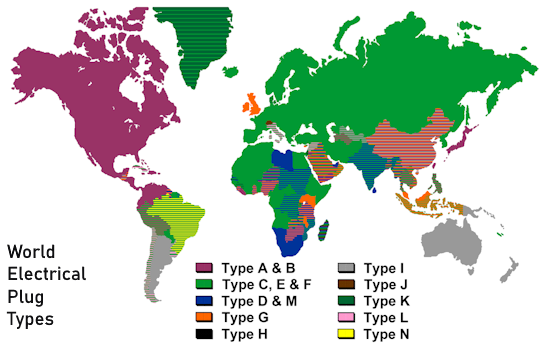
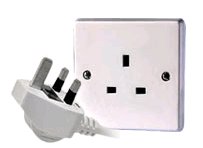
U.K. plug and
outlet
The Type G plug is commonly known as the 13-amp plug, and technically
known as the BS 1363 (British 13 A/230-240 V 50 Hz earthed and fused).
For safety reasons, UK wiring regulations require home sockets to have
shutters over the live and neutral connections. These shutters are
opened by the insertion of the longer earth pin. The shutters also help
prevent the use of incompatible plugs made to other standards. It is
sometimes possible to open the shutters with a screwdriver in order to
insert Type C or other plugs, but this is not advised, as such plugs
will not have a fuse.
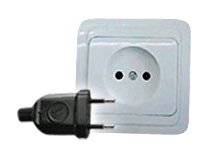
Popularly known as the Europlug, the Type C electrical plug is a
two-pin unearthed plug used throughout continental Europe, parts of the
Middle East, and much of Africa, South America, central Asia, and the
former Soviet republics.
The Type C plug is technically known as the CEE 7/16 (Europlug 2.5
A/250 V unearthed). There is a similar plug with slightly larger pins
known as the CEE 7/17. Both types are unearthed and have two round pins
which converge slightly. The CEE 7/16 is intended for devices that
require 2.5 A or less. The 19 mm separation of the pins and the pins' 4
mm length allow for its safe insertion in most Type C, Type E, Type F,
Type H, and some Type L outlets. The larger CEE 7/17 has a round
plastic or rubber base that prevents it from being inserted into small
sockets. The base has holes to accommodate the side contacts and socket
earth pins.
Plug Adapters
European electrical outlets come in different sizes and shapes. On the
European Continent, outlets normally require a plug with two round
prongs about 0.19 inch (4.8 mm) in diameter and 0.72 inch (18 to 19 mm)
apart. Outlets in some older locations accept a plug with slightly
smaller prongs.
If you have a laptop computer or other device which has an American
three prong grounded plug you will need a grounded plug adapter. The
Continental grounded plug has only two prongs on it but it has ground
connections on the perimeter of the plug. Newer outlets accept the
grounded plug. The standard grounded plug will not fit in the slightly
smaller holes of the old outlets. If you think you may run into this
problem, get an adapter beforehand.
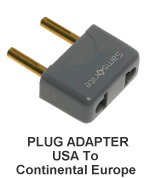
Most British and Irish facilities use a three prong plug, with two flat
prongs in line and one perpendicular. Newer facilities in Switzerland
have another kind of plug. This one has three round prongs in a
triangular pattern. In Eastern Europe it is more likely that you will
find the old style European plug, at least until the time when all
those countries adopt and implement EU (European Union) standards. The
old style has the two round narrow prongs, 0.15" in diameter.
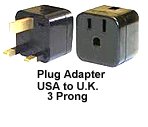
Universal Plug Adapters
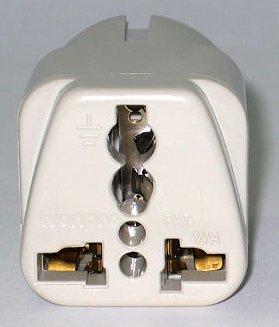
This plug adapter accepts multiple plugs for different countries.
FAQ
Question. Do voltage converters convert the frequency (Hz)?
Answer. Voltage converters only convert the voltage, not the
frequency. USA 110V electricity is generated at 60Hz AC. Many others
countries have 240V generated at 50Hz AC. The frequency difference
between 60 to 50Hz may cause the motor in a 60Hz appliance to operate
slightly slower when used at 50Hz. The frequency difference will also
cause analog clocks that use AC as the timing base to keep incorrect
time. Many modern electronic devices, including battery chargers,
computers, printers, stereos, tape and CD players, VCR/DVD players,
etc. will not be affected by the difference in frequency.
Q. Can I plug several appliances into a single transformer?
A. Yes, several appliances cam be plugged into a single transformer
using a power strip if and only if the combined wattage rating of all
products is less than the capacity of the transformer. However, don't
plug multiple products into a small travel converter.
Q. Is there a difference between a plug adaptor and a voltage
converter/transformer?
A. A plug adapter does not change the voltage of the electricity
supply. If the device is dual voltage, you can plug it into foreign
outlets by using a plug adapter. A voltage converter/transformer
actually changes the voltage from the supply level voltage to the value
used by the device. They allow you to use single voltage appliances in
foreign countries where the supply voltage is different to the voltage
which the device was designed for.
Media
Formats: TV
and other devices
TV broadcasts are not the same all over the world and if you try to use
an American TV in Europe it will not be able to receive local
broadcasts. The U.S. uses the ATSC standard for digital TV broadcasts
and since 2007, TV sets made for the U.S. have a built-in ATSC tuner.
In Europe the DVB-T standard is used for digital terrestrial TV
broadcasts and TV sets made for Europe have a DVB-T tuner. So in
addition to the voltage and power plug problems, you also have
incompatible TV broadcasts and tuners.
Most of the world is moving away from analog TV towards digital TV
signals and no, there is still no worldwide standard, meaning you still
have to be concerned about incompatible signals. There are some
multi-system TVs which will work on 110V-240V 50/60Hz but only have
analog tuners and maybe one type of digital tuner but not all. Some
kind of converter box may still be required to receive TV signals from
incompatible sources.
Multi-system HDTVs
# Worldwide NTSC/PAL/SECAM Color System
# Worldwide NTSC, PAL BG, PAL I, Secam BG, DK/ PAL DK TV tuners
# World Wide Voltage Supply AC 100-240V, 50/60Hz
Worldwide TV
broadcast standards
Before Digital TV
North America, Central America and the western coast countries of South
America, Japan, Bahamas, Bermuda, South Korea and a few other countries
used the NTSC analog TV standard. Most other countries used the analog
PAL TV standard except for France, Russia, and some African nations
which used the SECAM TV standard. Converting from one analog broadcast
standard to another means changing the video frame rate from 30 frames
per second in NTSC to 25 frames per second in PAL and the scan line
rate of 525 lines in NTSC to 625 lines in PAL. Converting PAL or NTSC
to SECAM is of dwindling need as televisions sold in SECAM countries
support SECAM and PAL and manufacturers are no longer producing video
recording and playback equipment that accept or output a SECAM analog
signal.

The North American analog TV standard was NTSC, while most of the rest
of the world used forms of PAL or SECAM analog TV.
Digital TV
The United States established its national standard for terrestrial
broadcasts of high-definition digital television, known as ATSC (for
Advanced Television Systems Committee), in 1996. The European Union
settled on its standard, Digital Video Broadcast-Terrestrial, or DVB-T,
in 1997. Japan developed its Integrated Services Digital
Broadcasting-Terrestrial (ISDB-T) in the 1980s and adopted it in
2003. China finalized its digital television standard in late
2006. Each TV has a tuner for over-the-air broadcasts based upon the
location it will be used in. Therefore a TV made for USA will have an
ATSC digital TV tuner while a TV made for UK will have a DVB-T tuner
built-in. So you can see that TV reception would be problematic for a
TV made with an ATSC tuner for United States use, moved to United
Kingdom because the TV signals are different.
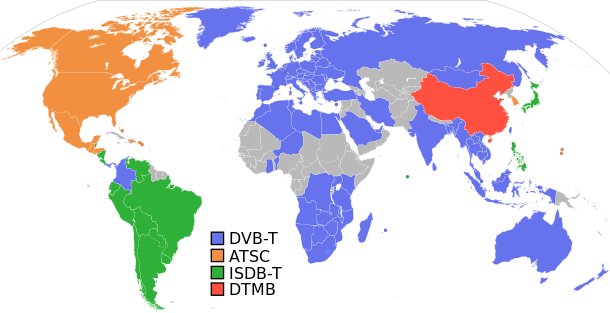
Digital TV standards worldwide
• See
over 100 hookup diagrams
• Surround
Sound
• Camcorder
Formats
• How
to choose a Camcorder
• HDMI
Switch box
• VCR
Basics
• HDTV
• How
to connect DVD player in 10 easy steps
• HDTV
Basic Setup
How
do I hookup my DVD player using component video?
How
do I setup my DVD player for surround sound?
How
do I hookup my DVD player with DVI or HDMI connections?
|
|


